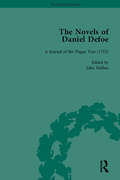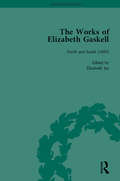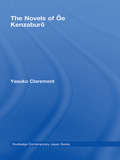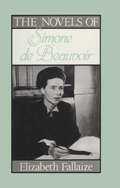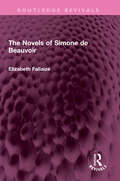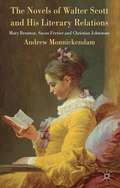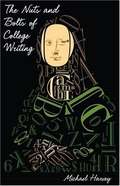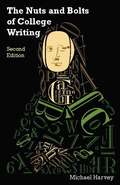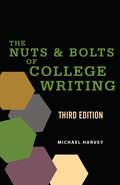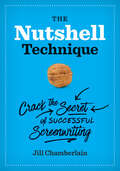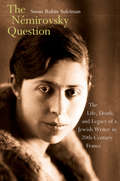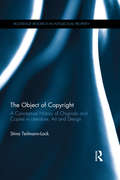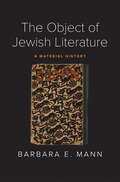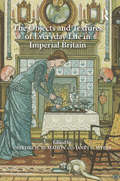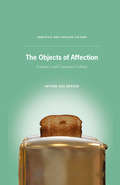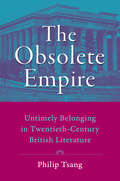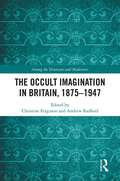- Table View
- List View
The Novels of Daniel Defoe, Part II vol 7 (The\pickering Masters Ser. #Vol. 6-10)
by John Mullan Maurice Hindle Liz Bellamy W R Owens P N Furbank John McVeaghBrings together three parts of "Robinson Crusoe" and examines their relationship. This work contains editorial material that includes a substantial introduction to each novel, explanatory endnotes, textual notes, and a consolidated index.
The Novels of Daniel Defoe, Part II vol 8 (The\pickering Masters Ser. #Vol. 6-10)
by John Mullan Maurice Hindle Liz Bellamy W R Owens P N Furbank John McVeaghBrings together three parts of "Robinson Crusoe" and examines their relationship. This work contains editorial material that includes a substantial introduction to each novel, explanatory endnotes, textual notes, and a consolidated index.
The Novels of Daniel Defoe, Part II vol 9 (The\pickering Masters Ser. #Vols. 1-5)
by John Mullan Maurice Hindle Liz Bellamy W R Owens P N Furbank John McVeaghBrings together three parts of "Robinson Crusoe" and examines their relationship. This work contains editorial material that includes a substantial introduction to each novel, explanatory endnotes, textual notes, and a consolidated index.
The Novels of Oe Kenzaburo (Routledge Contemporary Japan Series)
by Yasuko ClaremontÔe Kenzaburô was awarded the Nobel Prize for Literature in 1994. This critical study examines Ôe’s entire career from 1957 – 2006 and includes chapters on Ôe’s later novels not published in English. Through close readings at different points in Ôe’s career Yasuko Claremont establishes the spiritual path that he has taken in its three major phrases of nihilism, atonement, and salvation, all highlighted against a background of violence and suicidal despair that saturate his pages. Ôe uses myth in two distinct ways: to link mankind to the archetypal past, and as a critique of contemporary society. Equally, he depicts the great themes of redemption and salvation on two levels: that of the individual atoning for a particular act, and on a universal level of self-abnegation, dying for others. In the end it is Ôe’s ethical concerns that win out, as he turns to the children, the inheritors of the future, ‘new men in a new age’ who will have the power and desire to redress the ills besetting the world today. Essentially, Ôe is a moralist, a novelist of ideas whose fiction is densely packed with references from Western thought and poetry. This book is an important read for scholars of Ôe Kenzaburô’s work and those studying Japanese Literature and culture more generally.
The Novels of Simone De-Beauvoir
by Elizabeth FallaizeFirst published in 1988, The Novels of Simone de Beauvoir concentrates specifically on the novels of the famous 20th Century French writer, Simone de Beauvoir. Her novels are popular with both the students and general readers of literature and philosophy, and they will welcome this authoritative introduction to Beauvoir's fiction. The author examines Beauvoir's choice of narrative strategies and interprets them both in relation to the sexual politics of writing and in relation to the place which the constraints of history, class and gender increasingly play in the texts. All quotations are translated.
The Novels of Simone de Beauvoir (Routledge Revivals)
by Elizabeth FallaizeFirst published in 1988, The Novels of Simone de Beauvoir concentrates specifically on the novels of the famous 20th Century French writer, Simone de Beauvoir. Her novels are popular with both the students and general readers of literature and philosophy, and they will welcome this authoritative introduction to Beauvoir’s fiction. The author examines Beauvoir’s choice of narrative strategies and interprets them both in relation to the sexual politics of writing and in relation to the place which the constraints of history, class and gender increasingly play in the texts. All quotations are translated.
The Novels of Walter Scott and his Literary Relations
by Andrew MonnickendamUsing a wealth of diverse source material this book comprises an innovative critical study which, for the first time, examines Scott through the filter of his female contemporaries. It not only provides thought-provoking ideas about their handling of, for example, the love-plot, but also produces a different, more sombre Scott.
The Novels of William Faulkner: A Critical Interpretation
by Olga W. Vickery"[Vickery's] analyses of the structure of the novels are often nothing less than brilliant. . . . These are acts of genuine critical perception which pass from explication to illumination."--Dalhousie Review When Olga W. Vickery's revised edition of The Novels of William Faulkner appeared in 1964, two years after Faulkner's death, it was immediately hailed by reviewers. Thirty years later Vickery's work remains the preeminent interpretation of Faulkner in the formalist critical tradition while it inspires Faulknerians of all methodologies. Part One contains detailed analyses of every novel from Soldiers' Payto The Reivers, with particular emphasis on elucidation of character, theme, and structural technique. Part Two discusses interrelated patterns and preoccupations in Faulkner's writing generally. The Novels of William Faulkner continues to be of enormous benefit and delight to readers and scholars.
The Nuts and Bolts of College Writing
by Michael HarveyEngagingly written and filled with judicious examples, this short, practical, inexpensive handbook combines advice on writing clearly and plainly, structuring a piece of argumentative writing, and avoiding grammatical and other common mechanical errors -- including those in quoting and citing.
The Nuts and Bolts of College Writing
by Michael HarveyOUT OF PRINT EDITION - 2nd Edition now available "With concision and wit, Harvey shows college students how to write papers that are clear, cogent--and also stylish." --James Miller, Editor, Dædalus
The Nuts and Bolts of College Writing
by Michael HarveyThis "worthy successor to Strunk and White" now features an expanded style guide covering a wider range of citation cases, complete with up-to-date formats for Chicago, MLA, and APA styles.
The Nuts and Bolts of College Writing
by Michael HarveyUpdated for the needs of today's students—and with handy citation style guides adapted from The Chicago Manual of Style, Seventeenth Edition, the MLA Handbook, Eighth Edition, and the Publication Manual of the APA , Seventh Edition—the third edition of The Nuts and Bolt of College Writing offers essential guidance for college writers at all levels.Praise for previous editions: "This wonderful little book has helped improve the level of writing in all the courses I teach. No one should graduate from college without having used it." —Gonzalo Munevar, Lawrence Technological University "With concision and wit, Harvey shows college students how to write papers that are clear, cogent, and also stylish." —James Miller, editor, Dædalus "Simply the best guide to clear and effective writing since Strunk and White. Indispensable for students—and for their teachers." —Terry Nardin, University of Wisconsin–Milwaukee
The Nutshell Technique: Crack the Secret of Successful Screenwriting
by Jill ChamberlainA veteran Hollywood script consultant unlocks the secrets of storytelling in this &“clever, fresh way of analyzing structure&” (Creative Screenwriting magazine). Veteran script consultant Jill Chamberlain knows that most first-time screenwriters don&’t understand how to tell a story. These writers may have snappy dialogue, interesting characters, and clever plot devices—but what they deliver isn&’t a story. It&’s a situation. In order to explain the difference, Chamberlain created the Nutshell Technique, a method whereby writers identify eight dynamic, interconnected elements that are required to successfully tell a story. In this book, Chamberlain uses easy-to-follow diagrams (&“nutshells&”) to explain how the Nutshell Technique can make or break a film script. She takes readers step-by-step through thirty classic and contemporary movies, showing how such dissimilar screenplays as Casablanca, Chinatown, Pulp Fiction, Little Miss Sunshine, Juno, and Argo all have the same system working behind the scenes. She then teaches readers how to apply these principles to their own screenwriting.
The Nutshell Technique: Crack the Secret of Successful Screenwriting
by Jill ChamberlainA veteran Hollywood script consultant unlocks the secrets of storytelling in this &“clever, fresh way of analyzing structure&” (Creative Screenwriting magazine). Veteran script consultant Jill Chamberlain knows that most first-time screenwriters don&’t understand how to tell a story. These writers may have snappy dialogue, interesting characters, and clever plot devices—but what they deliver isn&’t a story. It&’s a situation. In order to explain the difference, Chamberlain created the Nutshell Technique, a method whereby writers identify eight dynamic, interconnected elements that are required to successfully tell a story. In this book, Chamberlain uses easy-to-follow diagrams (&“nutshells&”) to explain how the Nutshell Technique can make or break a film script. She takes readers step-by-step through thirty classic and contemporary movies, showing how such dissimilar screenplays as Casablanca, Chinatown, Pulp Fiction, Little Miss Sunshine, Juno, and Argo all have the same system working behind the scenes. She then teaches readers how to apply these principles to their own screenwriting.
The Némirovsky Question: The Life, Death, and Legacy of a Jewish Writer in Twentieth-Century France
by Susan Rubin SuleimanIrène Némirovsky succeeded in creating a brilliant career as a novelist in the 1930s, only to have her life cut short: a “foreign Jew” in France, she was deported in 1942 and died in Auschwitz. But her two young daughters survived, and as adults they brought their mother back to life. In 2004, Suite française, Némirovsky’s posthumous novel, became an international best seller; some critics, however, condemned her as a “self-hating Jew” whose earlier works were rife with anti-Semitic stereotypes. Informed by personal interviews with Némirovsky’s descendants and others, as well as by extensive archival research, this wide-ranging intellectual biography situates Némirovsky in the literary and political climate of interwar France and recounts, for the first time, the postwar lives of her daughters. Némirovsky's Jewish works, Suleiman argues, should be read as explorations of the conflicted identities that shaped the lives of secular Jews in twentieth-century Europe and beyond.
The Oak and the Calf: Sketches of Literary Life in the Soviet Union
by Alexander Solzhenitsyn Harry WillettsThis fragment about the author's life describes the repression of ideas in the Soviet Union during the 1960s.
The Object of Copyright: A Conceptual History of Originals and Copies in Literature, Art and Design (Routledge Research in Intellectual Property)
by Stina Teilmann-LockRecent years have seen a number of pressing developments in copyright law: there has been an enormous increase in the range and type of work accorded protection; the concept of the ‘original work’ has entered into national copyright acts; and intangible entities are now entitled to protection by copyright. All these are consequences of legislative and technological developments that can be traced back over two centuries and more. the result. This book presents an interdisciplinary study of the growth of copyright law, largely based on archival research and on archival materials only recently made available online. The new history here articulated helps to explain why print is no longer today the sole or even the chief object of copyright protection. Taking its key examples from British, French and Danish copyright law, the book begins by exploring how the earliest copyright laws emerged out of the technological understanding of a printed ‘copy,’ and out of the philosophical notions of originals and copies, tangibles and intangibles. Dr Teilmann-Lockgoes on to examine the concept of the ‘work’ as it develops both conceptually and legally, as the object of protection, and then explains how, in a curious consequence, 'the work' turns the ‘copy’ into the 'mere' material instantiation of the intangible 'original'. The book concludes by addressing the considerable and complicated problems now emerging in copyright law following the inclusion of design within the scope of its protection. In this field Danish law, striving to protect Danish design, has been setting the trend for over a hundred years. In its examination of terminological exchanges between the diverse legal traditions and philosophical discourse, and in its thorough investigation of particular terms central to copyright legislation, this interdisciplinary book will be of great interest to scholars and students of copyright and intellectual property law; it also makes an important contribution to literary studies, legal history and cultural theory.
The Object of Jewish Literature: A Material History
by Barbara E. MannA history of modern Jewish literature that explores our enduring attachment to the book as an object With the rise of digital media, the "death of the book” has been widely discussed. But the physical object of the book persists. Here, through the lens of materiality and objects, Barbara E. Mann tells a history of modern Jewish literature, from novels and poetry to graphic novels and artists’ books. Bringing contemporary work on secularism and design in conversation with literary history, she offers a new and distinctive frame for understanding how literary genres emerge. The long twentieth century, a period of tremendous physical upheaval and geographic movement, witnessed the production of a multilingual canon of writing by Jewish authors. Literature’s objecthood is felt not only in the physical qualities of books—bindings, covers, typography, illustrations—but also through the ways in which materiality itself became a practical foundation for literary expression.
The Objects and Textures of Everyday Life in Imperial Britain
by Deirdre H. McMahon Janet C. MyersFocusing on everyday life in nineteenth-century Britain and its imperial possessions”from preparing tea to cleaning the kitchen, from packing for imperial adventures to arranging home décor”the essays in this collection share a common focus on materiality, the nitty-gritty elements that helped give shape and meaning to British self-definition during the period. Each essay demonstrates how preoccupations with common household goods and habits fueled contemporary debates about cultural institutions ranging from personal matters of marriage and family to more overtly political issues of empire building. While existing scholarship on material culture in the nineteenth century has centered on artifacts in museums and galleries, this collection brings together disparate fields”history of design, landscape history, childhood studies, and feminist and postcolonial literary studies”to focus on ordinary objects and practices, with specific attention to how Britons of all classes established the tenets of domesticity as central to individual happiness, national security, and imperial hegemony.
The Objects of Affection
by Arthur Asa BergerIn this book, pre-eminent semiotician Arthur Asa Berger decodes the meanings of common objects of consumption and their perceived 'sacredness' in consumerist cultures. Using semiotic theory, consumer culture is dissected in new and fascinating ways.
The Objects of Affection: Semiotics and Consumer Culture (Semiotics and Popular Culture)
by A. BergerIn this book, pre-eminent semiotician Arthur Asa Berger decodes the meanings of common objects of consumption and their perceived 'sacredness' in consumerist cultures. Using semiotic theory, consumer culture is dissected in new and fascinating ways.
The Observing Self: Rediscovering the Essay (Routledge Revivals)
by Graham GoodFirst published in 1988, this title is a study of the essay as a literary genre, not just in terms of its general intellectual and literary history, but as an exploration of the creative possibilities of the form. The rise of the essay is discussed in relation to the rise of the novel and the emergence of empiricism in science, but the main focus of Graham Good’s study is on the inner workings of the essay itself. Drawing on criticism by Adorno and Lukacs, Graham Good presents the genre as an expression of individualism, freed from tradition and authority, in which the self constructs itself and its object through independent observation. Through analysis of the work of such essayists as Montaigne, Bacon, Virginia Wolf, T. S. Eliot and George Orwell, the potential of the genre for independence and individualism is illustrated, and the essay is resituated as an intellectually challenging form of creative and critical writing.
The Obsolete Empire: Untimely Belonging in Twentieth-Century British Literature (Hopkins Studies in Modernism)
by Philip TsangModernist literature at the end of the British empire challenges conventional notions of homeland, heritage, and community.The waning British empire left behind an abundance of material relics and an inventory of feelings not easily relinquished. In The Obsolete Empire, Philip Tsang brings together an unusual constellation of writers—Henry James, James Joyce, Doris Lessing, and V. S. Naipaul—to trace an aesthetics of frustrated attachment that emerged in the wake of imperial decline. Caught between an expansive Britishness and an exclusive Englishness, these writers explored what it meant to belong to an empire that did not belong to them.Thanks to their voracious reading of English fiction and poetry in their formative years, all of these writers experienced a richly textured world with which they deeply identified but from which they felt excluded. The literary England they imagined, frozen in time and out of place with the realities of imperial decline, in turn figures in their writings as a repository of unconsummated attachments, contradictory desires, and belated exchanges. Their works arrest the linear progression from colonial to postcolonial, from empire to nation, and from subject to citizen. Drawing on a rich body of scholarship on affect and temporality, Tsang demonstrates how the British empire endures as a structure of desire that outlived its political lifespan. By showing how literary reading sets in motion a tense interplay of intimacy and exclusion, Tsang investigates a unique mode of belonging arising from the predicament of being conscripted into a global empire but not desired as its proper citizen. Ultimately, The Obsolete Empire asks: What does it mean to be inside or outside any given culture? How do large-scale geopolitical changes play out at the level of cultural attachment and political belonging? How does literary reading establish or unsettle narratives of who we are? These questions preoccupied writers across Britain's former empire and continue to resonate today.
The Occult Imagination in Britain, 1875-1947 (Among the Victorians and Modernists)
by Andrew Radford Christine FergusonBetween 1875 and 1947, a period bookended, respectively, by the founding of the Theosophical Society and the death of notorious occultist celebrity Aleister Crowley, Britain experienced an unparalleled efflorescence of engagement with unusual occult schema and supernatural phenomena such as astral travel, ritual magic, and reincarnationism. Reflecting the signal array of responses by authors, artists, actors, impresarios and popular entertainers to questions of esoteric spirituality and belief, this interdisciplinary collection demonstrates the enormous interest in the occult during a time typically associated with the rise of secularization and scientific innovation. The contributors describe how the occult realm functions as a turbulent conceptual and affective space, shifting between poles of faith and doubt, the sacrosanct and the profane, the endemic and the exotic, the forensic and the fetishistic. Here, occultism emerges as a practice and epistemology that decisively shapes the literary enterprises of writers such as Dion Fortune and Arthur Machen, artists such as Pamela Colman Smith, and revivalists such as Rolf Gardiner
The Occult Nineteenth Century: Roots, Developments, and Impact on the Modern World (Palgrave Studies in New Religions and Alternative Spiritualities)
by Franz Winter Lukas PokornyThe nineteenth century witnessed a proliferation of alternative religious currents and practices, appropriating earlier traditions, entangling geographically distinct spiritual discourses, and crafting a repository of mindscapes eminently suitable to be accommodated by later generations of thinkers and practitioners. Penned by specialists in the field, this volume examines important themes and figures pertaining to this occult amalgam and its resonance into the twentieth century and beyond. Global guises of the occult, ranging from the Americas and Europe to India, are variously addressed, with special attention to the crucial role of mesmerism and the origins of modern yoga.
